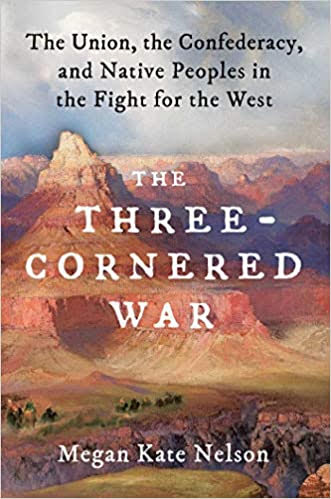"The Three-Cornered War" by Megan Kate Nelson

Above: "The Three Cornered War." Megan Kate Nelson. 244 pages.
I had never heard of the forced march, engineered by Carlton, of some three thousand Navahos from their ancestral home in what is today northeastern Arizona, four hundred miles to a reservation east of the Rio Grande.
I completed reading this book today. 13 November 2020.
Sergio Leone's apex "spaghetti western," "The Good, The Bad, and the Ugly," is on my top ten list of all time favorite movies. I watch the Clint Eastwood/Lee Van Cleef acted film, kept in my personal collection, at least twice, sometimes three times, a year. But, I never understood how the setting for the film, New Mexico replete with Union and Confederate soldiers, was related to the Civil War.
But, Leone's New Mexico Civil War setting was perfectly in accordance with history. I found out about it by reading this book.
At the start of the Civil War, in 1861, A group of Texas Regulars rode northwest, from San Antonio, along the Rio Grande River and reached as far as Messila, New Mexico. Under the direction of Colonel John Baylor, the Confederates claimed everything south of Messila, east of California, and west of Texas, as "The Confederate Territory of Arizona."
A few months later, a group of Texans under the leadership of General Henry Hopkins Sibley, formed the "Sibley Brigade," in Texas and marched to join Baylor's forces in Messila. Sibley tells Baylor to go fight Indians and takes his "Sibley Brigade" to Fort Craig, where he defeats Federal Troops, under the direction of General Edward Canby, at the Battle of Valverde.
The Confederates went on to occupy Albuquerque, and later, Santa Fe. Things were looking good for the Sibley Brigade. Richmond was pleased. Colorado in the north California to the west were within reach.
But, Sibley outstripped his supply lines as he moved north towards Fort Union, gateway to Colorado Territory. Confederates won the battle of Glorieta Pass, northeast of Santa Fe, but a group Union regulars did an end run over the top of a a mesa and destroyed the loosely guarded Confederate supply wagons in Santa Fe. Bereft of stores, by late 1862, the Confederates had withdrawn from New Mexico never to return.
But, Confederate departure didn't mean Union troops could let up. General John Carleton's troops came from California to replace General Canby in Santa Fe. Carleton 's charge? Deal with those pesky Indians who were impeding the process of Anglo settlers colonizing southwestern lands.
The Indians had to be rounded up, and sent to far away reservations. Some of them, to say the least, didn't like that prospect.
The US dealings with Magnus Coloradas, and his son in law, Cochise, Apache chiefs, are chronicled in the narrative.
I had never heard of the forced march, engineered by Carlton, of some three thousand Navahos from their ancestral home in what is today northeastern Arizona, four hundred miles to a reservation east of the Rio Grande. There, after four seasons of failed crops, the Navajos went on strike. None other than William Tecumseh Sherman of Civil War fame, approved a return of the Navahos to their ancestral lands.
Author Nelson introduces nine individuals: John R. Baylor, a Texas legislator who established the Confederate Territory of Arizona; Louisa Hawkins Canby, a Union Army wife who nursed Confederate soldiers back to health in Santa Fe; James Carleton, a professional soldier who engineered campaigns against Navajos and Apaches; Kit Carson, a famous frontiersman who led a regiment of volunteers against the Texans, Navajos, Kiowas, and Comanches; Juanita, a Navajo weaver who resisted Union campaigns against her people; Bill Davidson, a soldier who fought in all of the Confederacy’s major battles in New Mexico; Alonzo Ickis, an Iowa-born gold miner who fought on the side of the Union; John Clark, a friend of Abraham Lincoln’s who embraced the Republican vision for the West as New Mexico’s surveyor-general; and Mangas Coloradas, a revered Chiricahua Apache chief who worked to expand Apache territory in Arizona.
This book cites American history of which most Americans are ignorant. I was ignorant. Two years ago I rode a motorcycle from Raton Pass, NM through Glorieta Pass, NM, totally unaware that an important Civil War battle was fought there.
You can only read so much. But, if you consider yourself a US west history aficionado, this book fills in a lot of gaps.
Going back to the movie, "The Good, the Bad, and the Ugly," I did some research and found that the Sibley Brigade, and Canby's pushback, are referred to in the film.
At seventy-five years of age, I'm not sure what good having this new knowledge of the American Southwest during the Civil War does for me. But, picking up this new information provided a lot of enjoyment.